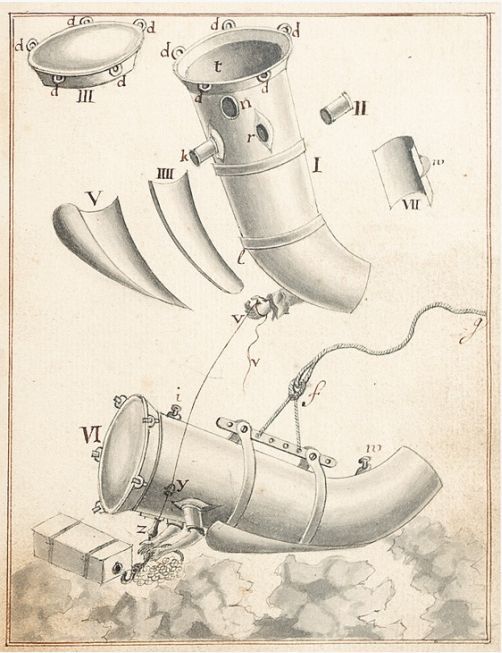
This is not a diving bell - more a diving chamber, since the diver
was at atmospheric pressure [though see discussion below]. So very
similar to an earlier design, that by John Lethbridge in 1715, but with
some improvements. Indeed Lethbridge and Rowe collaborated in the
recovery of great value from the wreck of the East-Indiaman Vansittart
(lost 1719, on Maio - Cape Verde Islands).
It gives a
flavour of what was possible before pumps became more efficient.
Used by Rowe to recover specie (coins) from the wreck of the Dutch East-Indiaman Adelaar wrecked on Greian Head, Barra, in 1728, position 57°00.85N, 7°31.33W. More info about the current situation of wreckage and the 1972 diving survey.
Illustration of Jacob Rowe's Diving Engine, from his book [from National
Maritime Museum]:

The machine was a truncated vessel of brass or copper (some versions were built of wooden staves like a barrel) in which the diver lay prone. His arms protruded through sealed sleeves of copper and leather, and he peered through a small glass port from which he was obliged to clear condensation with his nose. A lid secured with butterfly nuts provided entry. The engine was designed to be operated in a slightly head-up attitude, improving the diver's view and providing better arm-space when working on the bottom. It also kept water from gathering around his face in the event of a leak.
Enough lead to create slightly negative buoyancy was fastened beneath the apparatus, which was suspended by ropes from a mother-craft. A life-line provided communication with the surface. The diver could be lowered and raised with relatively little effort as long as buoyancy trim was correctly maintained, and this permitted the engine to be hauled up rapidly from time to time so that fresh air could be blown in with bellows. Under favourable conditions several hours of underwater work was possible, with regular air replenishment. A block-and-tackle hoist was employed to lift the machine clear of the water, or to bring it up in a flooded condition. Surprisingly, no arrangement seems to have been provided to jettison the ballast for an emergency bale-out.
In effect the engine was an armoured diving dress, although no protection was provided for the arms and the full differential between atmospheric pressure inside and ambient water-pressure outside would squeeze on the diver's upper arms where they emerged from the sleeves. This naturally increased with depth. A further effect was to push the diver's body by way of his arms against the top of the vessel, and a back-saddle was provided to counter this. Even at quite modest depths these forces would have been unpleasant and disorienting, yet it is clear that such devices were successfully operated in up to 10 fathoms (18 m) of water. This must have been close to a diver's physiological limits. Desaguliers reported that a Captain Irvin, who dived for Rowe, experienced a strong stricture about his arms at 11 fathoms, and that venturing two fathom lower to take up a lump of earth with Pieces of Eight sticking together; the circulation of his blood was so far stopped, and he suffered so much, that he was forced to keep to his bed six weeks. Another diver died after reaching 14 fathoms.
Since the diver's arms were exposed to the pressure of the outside
sea-water, it is hard to understand why blood flow to the arms was not
cut off when a difference of pressure between the diver's chest [inside]
and arm [outside] exceeded blood pressure [say 150 mmHg - which
corresponds to only 2 metres depth]. One factor that may have been
relevant is that the chamber let in water around the arm-holes, so if
the chamber inside was, for instance, half full of water, the inside air
pressure would correspond to a depth of 5 metres - so allowing diving to a
7 metre depth. Thus the device would have had some features that were
similar to a diving bell.
Lethbridge, himself, reported that he could stay down, in
his similar apparatus, for 30 minutes at 6 fathoms and 15 minutes at 10
fathoms, and that it took only 3 minutes to refresh the air at the
surface. He claimed to be able to work, thus, for a 8 hour period. The
shorter period reported under water at greater depth, suggests that the
air breathed was, indeed, at higher pressure in that case.